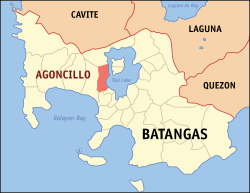Agoncillo, Batangas
This article needs additional citations for verification. (November 2013) |
Agoncillo | |
|---|---|
 | |
 Map of Batangas showing the location of Agoncillo | |
| Country | Philippines |
| Region | CALABARZON (Region IV-A) |
| Province | Batangas |
| District | 3rd District |
| Barangays | 21 |
| Government | |
| • Mayor | Daniel De Leos Reyes |
| Area | |
| • Total | 49.96 km2 (19.29 sq mi) |
| Population (2010)[3] | |
| • Total | 35,794 |
| • Density | 720/km2 (1,900/sq mi) |
| Time zone | UTC+8 (PST) |
| ZIP code | 4211 |
| Dialing code | 43 |
| Income class | 4th class |
Agoncillo is a fourth class municipality in the Province of Batangas, Philippines. According to the 2010 census, it has a population of 35,794 people.[3]
It is located 120 kilometres (75 mi) south of Manila, a two-hour drive via the scenic route of Tagaytay Ridge and R. Diokno Highway. It is 32 kilometres (20 mi) away from Batangas City, the provincial capital. Bounded in the east by approximately 10 kilometres (6.2 mi) lakeshore of Taal Lake, in the south by the municipality of San Nicolas, separated by Pansipit River on the west by the municipality of Lemery and on the north by the municipality of Laurel.
Barangays
Agonsilyo is politically subdivided into 21 barangays.[2]
History
During the Second World War under the Japanese Occupation, the occupation of the Imperial Japanese armed forces entering the towns in Agoncillo.
During the Battle for the Liberation of Batangas in 1944 to 1945, local Filipino troops of the 4th, 42nd, 43rd and 45th Infantry Division of the Philippine Commonwealth Army and 4th Infantry Regiment of the Philippine Constabulary was fought side by side and recapturing the towns in Agoncillo to helping the local guerrilla fighters and defeats Japanese Imperial forces ended World War II.
The Town of Agoncillo was originally a part of Lemery. In 1945, an executive committee was formed by the first appointed Mayor Jacinto Mendoza Sr. to prepare a resolution, requesting the Secretary of the Interior, Malacañan Palace, through the provincial board to detach and separate 11 barrios and be created a municipality.
By virtue of an Executive Order issued by President President Elpidio Quirino, the Municipality of Pansipit was created. But the Municipal Council of Lemery passed a resolution requesting for the revocation and suspension of the said creation. Thus, another executive order was endorsed for the conduct of a plebiscite to ascertain the true sentiments of the residents regarding the issue of separation.
Finally, on April 17, 1949, Executive Order No. 212 was issued by President Quirino, lifting the suspension and thereby, authorizing the immediate organization of the Municipality under the name of Agoncillo, in honor of Don Felipe Agoncillo, a native of Taal and one of the first Filipino representatives to the Spanish Cortes.
Demographics

| Year | Pop. | ±% p.a. |
|---|---|---|
| 1990 | 20,227 | — |
| 1995 | 23,358 | +2.73% |
| 2000 | 26,584 | +2.81% |
| 2007 | 33,990 | +3.45% |
| 2010 | 35,794 | +1.90% |
| Source: National Statistics Office[3] | ||
Local government
The current set of local government officials were elected in 2013 and their term will expire in 2016. The municipal mayor is Daniel D. Reyes, and Domingo C. Encarnacion is the vice mayor and presiding officer of the Sangguniang Bayan which is composed of May Lacap-Martinez, Leonarda A. Enriquez, Constantino V. Hernandez, Edgar C. Carignal, Rosemelyn R. Fajardo-Roque, Alberto Reyes, Aaron R. B. Mendoza, and Nolasco C. Balba.[1]
References
- ^ a b "Official City/Municipal 2013 Election Results". Intramuros, Manila, Philippines: Commission on Elections (COMELEC). 11 September 2013. Retrieved 11 November 2013.
- ^ a b "Province: BATANGAS". PSGC Interactive. Makati City, Philippines: National Statistical Coordination Board. Retrieved 11 November 2013.
- ^ a b c "Total Population by Province, City, Municipality and Barangay: as of May 1, 2010" (PDF). 2010 Census of Population and Housing. National Statistics Office. Retrieved 11 November 2013.

